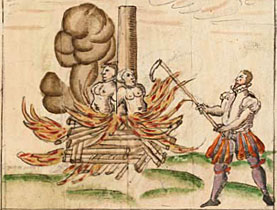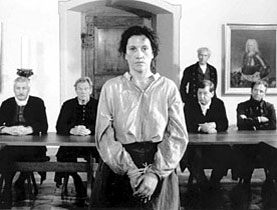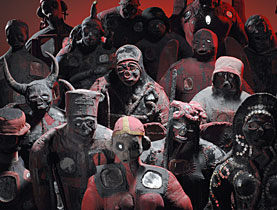Witches exhibition casts a spell

Between 1423 and 1666, the small town of Sursee in central Switzerland hosted 59 witchcraft trials. Most defendants were found guilty, beheaded or burnt at the stake.
Just a few steps away from the scene of public executions, a museum is currently taking a look at the witchcraft hysteria of the 15th and 16th centuries.
For Sursee was not unusual; this fear of witches was especially common in the area encompassing present-day France, Switzerland and Germany.
“Suddenly, the cow stopped providing milk. A hailstorm ruined the crops. Or maybe the husband was impotent,” explains Sibylle Gut, curator at the Sankturbanhof museum in Sursee.
“People were looking for scapegoats to take the blame.”
She and her team have created an exhibition that plunges visitors back into the days of darkness and superstition.
Unsettling times
The first part of the exhibition takes guests back in time through the senses of sight, sound and even smell.
The ceiling is low, the lighting dim; antique household items and farm tools create the atmosphere of the time. The sounds of creaking horse-drawn carts and crying babies are mildly unsettling, while incense adds a whiff of mystery.
With the scene set, visitors have the chance to arm themselves with holy water, salt or bread in the effort to ward off witchcraft.
But as other exhibits show, in the past people weren’t content with these simple means of protection. In addition, some carried ornately decorated pouches that contained pictures of the saints.
Others went so far as to swallow the image of the Virgin, conveniently available in a tiny notebook with tear-off sheets. Yet others wore necklaces featuring gnarled bird feet and sharp rodent teeth.
And then there were “witch glasses”.
“People believed that witches glowed in the dark, a trait observable with the aid of witch glasses,” says Gut. Real glasses weren’t necessary; either a key with a large ring or a stone with a hole in it could do the job.
Supernatural
Literature and woodcuts dating back to the 1400s illustrate the supernatural characteristics of witches.
One item on show is a book printed in 1494 — a field guide to witches, their identifying behaviour, and the proper way to destroy them.
Seen as a threat to Christianity, those suspected of witchcraft were persecuted without mercy. A person formally accused of putting a hex on a neighbour was likely to face terrible consequences.
The authorities would probably torture the defendant until she confessed to that deed and others, such as having sexual relations with the devil. While up to 90 per cent of accused witches were women, it is worth noting that some were men.
Stocks, the rack and hot pliers were just some of the torture devices employed. A low-tech method involved hot eggs held under the arms. The woodcut illustrations bear gruesome witness to the fate of many of the accused.
A gleaming highlight of the exhibition is a sword once used to decapitate witches in Zurich. Even its victims were probably happy to see it, for it saved them from the agony of being burnt alive.
Witches today
Through the use of short video installations, the museum provides modern-day insight into real and imagined witchcraft. It includes a 1960s interview with a woman from central Switzerland whose life was shattered after her neighbours accused her of being a witch.
The exhibition also features interviews with real Swiss witches. One of them is Wicca, a high-priestess living in canton Aargau.
Asked what a witch is, she says, “A witch is someone who is very connected to nature. We make a lot of teas and salves.” She also mentions a possible genetic aspect to witchcraft, saying that some people seem to inherit special powers.
Then there’s Willie “Dreamdancer” Haas, witch and owner of Zwischenwelt, an esoteric boutique in Lucerne.
“You can’t just speak of black and white magic,” insists Haas, “There are hundreds of thousands of colours!”
He wryly suggests that people who participate in bullying could be accused of black magic.
And while a muggle – as Harry Potter would say – may never know whether that evil colleague is actually a bad witch or not, Haas is clear where he stands: “It’s wonderful to be a witch!”
swissinfo, Susan Vogel-Misicka in Sursee
Originally part of an abbey, Sankturbanhof has also been a guesthouse and a private home.
In 1997, it was converted into a museum. Its permanent collection includes paintings, coins and hunting weapons as well as Roman artifacts found in Sursee over the past couple of decades.
The Witches exhibition lasts until October 19, 2008.
Wicca, which is a religion, is one of the best-known forms of witchcraft. It emphasises spirituality and a deep connection to nature. Its golden rule is “Harm None”.
There are several museums worldwide dedicated to witches and witchcraft, including:
Museum of Witchcraft in Boscastle, Cornwall, Britain.
Salem Witch Museum as well as the Witch Dungeon and Witch History museums in Salem, Massachusetts, in the United States.

In compliance with the JTI standards
More: SWI swissinfo.ch certified by the Journalism Trust Initiative



You can find an overview of ongoing debates with our journalists here. Please join us!
If you want to start a conversation about a topic raised in this article or want to report factual errors, email us at english@swissinfo.ch.